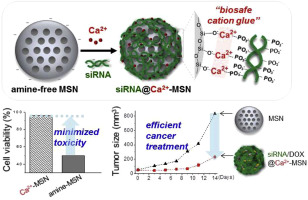当前位置:
X-MOL 学术
›
Biomaterials
›
论文详情
Our official English website, www.x-mol.net, welcomes your
feedback! (Note: you will need to create a separate account there.)
Cumulative directional calcium gluing between phosphate and silicate: A facile, robust and biocompatible strategy for siRNA delivery by amine-free non-positive vector.
Biomaterials ( IF 12.8 ) Pub Date : 2019-04-08 , DOI: 10.1016/j.biomaterials.2019.04.006 Eunshil Choi 1 , Juyong Lee 2 , Ick Chan Kwon 1 , Dong-Kwon Lim 3 , Sehoon Kim 4
Biomaterials ( IF 12.8 ) Pub Date : 2019-04-08 , DOI: 10.1016/j.biomaterials.2019.04.006 Eunshil Choi 1 , Juyong Lee 2 , Ick Chan Kwon 1 , Dong-Kwon Lim 3 , Sehoon Kim 4
Affiliation

|
For siRNA therapeutics, the use of positively charged amine-rich delivery vectors has been indispensable, but the amine-associated toxicological responses remain a clinical conundrum. Herein, we report a new strategy of harnessing a biocompatible, biodegradable and well-tolerated nanomaterial as an amine-free non-positive carrier for siRNA delivery. By employing mesoporous silica nanoparticles (MSNs) as a biocompatible vector, siRNA is loaded nonconventionally through calcium ion (Ca2+)-mediated interconnection (calcium gluing) between phosphates of siRNA and surface silicates of MSNs in a sequential, cumulative and directional way. The "one-pot" gluing process utilizing endogenously abundant Ca2+ ions offers a simple but robust means of siRNA loading on the non-positive bare surface of MSNs without the aid of multi-amine functionalization, and thus minimizes the risk of amine-associated cytotoxicity and immunogenicity while keeping the intrinsic biocompatibility of MSNs. As demonstrated with loading of an anticancer siRNA, this strategy allows stable in vivo delivery of siRNA for targeted gene silencing, and capitalizes on the unique structural versatility of MSNs by simultaneously delivering a pore-loaded chemodrug to synergistically enhance the treatment efficacy. Therefore, the Ca2+-glued MSNs as a general siRNA carrier platform provide a less toxic, less laborious and more utilitarian delivery tool for more effective and safer siRNA therapeutics.
中文翻译:

磷酸盐和硅酸盐之间的累积定向钙胶合:通过无胺非阳性载体进行siRNA传递的简便,可靠且生物相容的策略。
对于siRNA疗法,使用带正电荷的富含胺的递送载体是必不可少的,但是与胺相关的毒理学反应仍然是临床难题。在本文中,我们报告了一种利用生物相容性,可生物降解和良好耐受的纳米材料作为siRNA传递的无胺非阳性载体的新策略。通过使用介孔二氧化硅纳米粒子(MSNs)作为生物相容性载体,通过顺序,累积和定向方式,通过钙离子(Ca2 +)介导的siRNA磷酸盐和MSNs表面硅酸盐之间的相互连接(钙胶凝)非常规地加载siRNA。“一锅” 利用内源性丰富的Ca2 +离子进行胶合过程,可在不借助多胺功能化的情况下,将siRNA装载到MSNs的非阳性裸露表面上,提供一种简单而强大的方法,从而在保持内在固有性的同时,将与胺相关的细胞毒性和免疫原性的风险降到最低MSN的生物相容性。如载有抗癌siRNA所证明的,该策略允许稳定的siRNA体内递送以实现靶向基因沉默,并通过同时递送载有孔的化学药物来协同增强治疗功效,从而利用MSN独特的结构多功能性。因此,Ca2 +胶粘的MSN作为一般的siRNA载体平台,提供了毒性更小,工作量更少和实用性更高的递送工具,可用于更有效,更安全的siRNA治疗。因此,在保持MSN固有的生物相容性的同时,将与胺相关的细胞毒性和免疫原性的风险降到最低。如载有抗癌siRNA所证明的,该策略允许稳定的siRNA体内递送以实现靶向基因沉默,并通过同时递送载有孔的化学药物来协同增强治疗功效,从而利用MSN独特的结构多功能性。因此,Ca2 +胶粘的MSN作为一般的siRNA载体平台,提供了毒性更小,工作量更少和实用性更高的递送工具,可用于更有效,更安全的siRNA治疗。因此,在保持MSN固有的生物相容性的同时,将与胺相关的细胞毒性和免疫原性的风险降到最低。如载有抗癌siRNA所证明的,该策略允许稳定的siRNA体内递送以实现靶向基因沉默,并通过同时递送载有孔的化学药物来协同增强治疗功效,从而利用MSN独特的结构多功能性。因此,Ca2 +胶粘的MSN作为一般的siRNA载体平台,提供了毒性更小,工作量更少和实用性更高的递送工具,可用于更有效,更安全的siRNA治疗。并通过同时递送载有孔的化学药物来协同增强治疗功效,从而利用MSN独特的结构多功能性。因此,Ca2 +胶粘的MSN作为一般的siRNA载体平台,提供了毒性更小,工作量更少和实用性更高的递送工具,可用于更有效,更安全的siRNA治疗。并通过同时递送载有孔的化学药物来协同增强治疗功效,从而利用MSN独特的结构多功能性。因此,Ca2 +胶粘的MSN作为一般的siRNA载体平台,提供了毒性更小,工作量更少和实用性更高的递送工具,可用于更有效,更安全的siRNA治疗。
更新日期:2019-04-08
中文翻译:

磷酸盐和硅酸盐之间的累积定向钙胶合:通过无胺非阳性载体进行siRNA传递的简便,可靠且生物相容的策略。
对于siRNA疗法,使用带正电荷的富含胺的递送载体是必不可少的,但是与胺相关的毒理学反应仍然是临床难题。在本文中,我们报告了一种利用生物相容性,可生物降解和良好耐受的纳米材料作为siRNA传递的无胺非阳性载体的新策略。通过使用介孔二氧化硅纳米粒子(MSNs)作为生物相容性载体,通过顺序,累积和定向方式,通过钙离子(Ca2 +)介导的siRNA磷酸盐和MSNs表面硅酸盐之间的相互连接(钙胶凝)非常规地加载siRNA。“一锅” 利用内源性丰富的Ca2 +离子进行胶合过程,可在不借助多胺功能化的情况下,将siRNA装载到MSNs的非阳性裸露表面上,提供一种简单而强大的方法,从而在保持内在固有性的同时,将与胺相关的细胞毒性和免疫原性的风险降到最低MSN的生物相容性。如载有抗癌siRNA所证明的,该策略允许稳定的siRNA体内递送以实现靶向基因沉默,并通过同时递送载有孔的化学药物来协同增强治疗功效,从而利用MSN独特的结构多功能性。因此,Ca2 +胶粘的MSN作为一般的siRNA载体平台,提供了毒性更小,工作量更少和实用性更高的递送工具,可用于更有效,更安全的siRNA治疗。因此,在保持MSN固有的生物相容性的同时,将与胺相关的细胞毒性和免疫原性的风险降到最低。如载有抗癌siRNA所证明的,该策略允许稳定的siRNA体内递送以实现靶向基因沉默,并通过同时递送载有孔的化学药物来协同增强治疗功效,从而利用MSN独特的结构多功能性。因此,Ca2 +胶粘的MSN作为一般的siRNA载体平台,提供了毒性更小,工作量更少和实用性更高的递送工具,可用于更有效,更安全的siRNA治疗。因此,在保持MSN固有的生物相容性的同时,将与胺相关的细胞毒性和免疫原性的风险降到最低。如载有抗癌siRNA所证明的,该策略允许稳定的siRNA体内递送以实现靶向基因沉默,并通过同时递送载有孔的化学药物来协同增强治疗功效,从而利用MSN独特的结构多功能性。因此,Ca2 +胶粘的MSN作为一般的siRNA载体平台,提供了毒性更小,工作量更少和实用性更高的递送工具,可用于更有效,更安全的siRNA治疗。并通过同时递送载有孔的化学药物来协同增强治疗功效,从而利用MSN独特的结构多功能性。因此,Ca2 +胶粘的MSN作为一般的siRNA载体平台,提供了毒性更小,工作量更少和实用性更高的递送工具,可用于更有效,更安全的siRNA治疗。并通过同时递送载有孔的化学药物来协同增强治疗功效,从而利用MSN独特的结构多功能性。因此,Ca2 +胶粘的MSN作为一般的siRNA载体平台,提供了毒性更小,工作量更少和实用性更高的递送工具,可用于更有效,更安全的siRNA治疗。













































 京公网安备 11010802027423号
京公网安备 11010802027423号